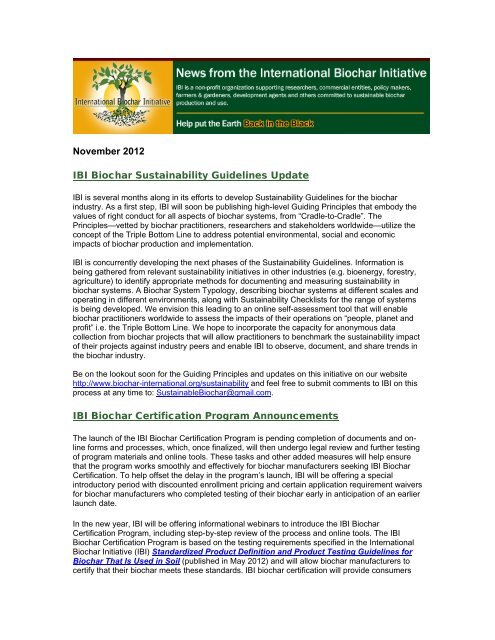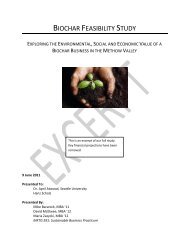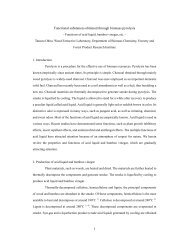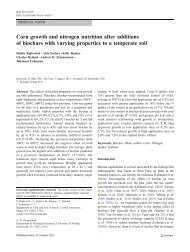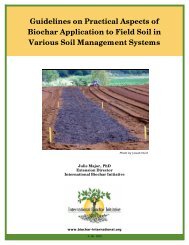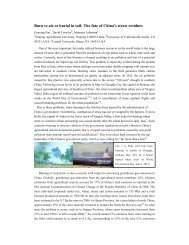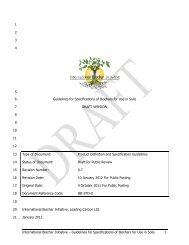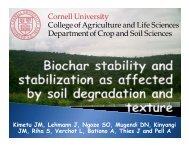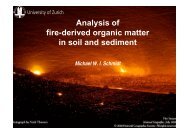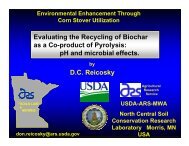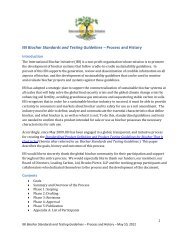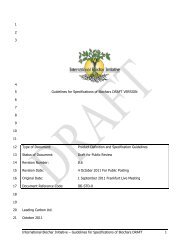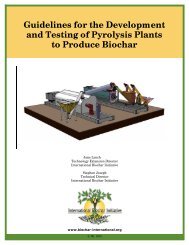November 2012 - International Biochar Initiative
November 2012 - International Biochar Initiative
November 2012 - International Biochar Initiative
Create successful ePaper yourself
Turn your PDF publications into a flip-book with our unique Google optimized e-Paper software.
<strong>November</strong> <strong>2012</strong><br />
IBI <strong>Biochar</strong> Sustainability Guidelines Update<br />
IBI is several months along in its efforts to develop Sustainability Guidelines for the biochar<br />
industry. As a first step, IBI will soon be publishing high-level Guiding Principles that embody the<br />
values of right conduct for all aspects of biochar systems, from “Cradle-to-Cradle”. The<br />
Principles—vetted by biochar practitioners, researchers and stakeholders worldwide—utilize the<br />
concept of the Triple Bottom Line to address potential environmental, social and economic<br />
impacts of biochar production and implementation.<br />
IBI is concurrently developing the next phases of the Sustainability Guidelines. Information is<br />
being gathered from relevant sustainability initiatives in other industries (e.g. bioenergy, forestry,<br />
agriculture) to identify appropriate methods for documenting and measuring sustainability in<br />
biochar systems. A <strong>Biochar</strong> System Typology, describing biochar systems at different scales and<br />
operating in different environments, along with Sustainability Checklists for the range of systems<br />
is being developed. We envision this leading to an online self-assessment tool that will enable<br />
biochar practitioners worldwide to assess the impacts of their operations on “people, planet and<br />
profit” i.e. the Triple Bottom Line. We hope to incorporate the capacity for anonymous data<br />
collection from biochar projects that will allow practitioners to benchmark the sustainability impact<br />
of their projects against industry peers and enable IBI to observe, document, and share trends in<br />
the biochar industry.<br />
Be on the lookout soon for the Guiding Principles and updates on this initiative on our website<br />
http://www.biochar-international.org/sustainability and feel free to submit comments to IBI on this<br />
process at any time to: Sustainable<strong>Biochar</strong>@gmail.com.<br />
IBI <strong>Biochar</strong> Certification Program Announcements<br />
The launch of the IBI <strong>Biochar</strong> Certification Program is pending completion of documents and online<br />
forms and processes, which, once finalized, will then undergo legal review and further testing<br />
of program materials and online tools. These tasks and other added measures will help ensure<br />
that the program works smoothly and effectively for biochar manufacturers seeking IBI <strong>Biochar</strong><br />
Certification. To help offset the delay in the program’s launch, IBI will be offering a special<br />
introductory period with discounted enrollment pricing and certain application requirement waivers<br />
for biochar manufacturers who completed testing of their biochar early in anticipation of an earlier<br />
launch date.<br />
In the new year, IBI will be offering informational webinars to introduce the IBI <strong>Biochar</strong><br />
Certification Program, including step-by-step review of the process and online tools. The IBI<br />
<strong>Biochar</strong> Certification Program is based on the testing requirements specified in the <strong>International</strong><br />
<strong>Biochar</strong> <strong>Initiative</strong> (IBI) Standardized Product Definition and Product Testing Guidelines for<br />
<strong>Biochar</strong> That Is Used in Soil (published in May <strong>2012</strong>) and will allow biochar manufacturers to<br />
certify that their biochar meets these standards. IBI biochar certification will provide consumers
critical safety and use assurances related to the quality and characteristics of the biochar, and for<br />
biochar manufacturers, certification opportunities for biochar materials will provide market and<br />
investor assurances that are necessary to drive commercialization of this important industry.<br />
For questions or further inquiries regarding the IBI <strong>Biochar</strong> Certification Program, please contact<br />
us at certification@biochar-international.org.<br />
IBI Releases new Research Summary on <strong>Biochar</strong> and Field Trials<br />
IBI recently published a new research summary of peer reviewed and published literature that<br />
highlights the impact of biochar on crop yield, economic performance, fertilizer use efficiency and<br />
soil fertility, water uptake/availability, mycorrhizal fungi colonization and microbial activity, and<br />
greenhouse gas flux. It exclusively examines biochar field studies, defined as biochar<br />
experiments that were located, measured, and observed in the outdoors for an extended period<br />
of time (at least one growing season). While not excluding post-growing season lab analyses, this<br />
summary does not include any examinations of the effects of biochar in a controlled laboratory<br />
setting. The field studies that are included in this research summary ranged in plot size from 1m x<br />
2.25m to 1,000m2. We wish to thank the primary author, Josh Laufer, for his dedicated research,<br />
writing, editing and revisions as well as the IBI Advisory Committee for their thorough reviews.<br />
The research summary is available at the IBI Publications page (link to: http://www.biocharinternational.org/publications/IBI)<br />
or directly at: http://www.biocharinternational.org/sites/default/files/IBI_Field_Studies_Research_Summary_final.pdf.<br />
Profile: Synergies in Sunitsch Canyon—Tierra Learning Center<br />
Discovers <strong>Biochar</strong><br />
In September <strong>2012</strong>, lighting struck a<br />
forested ridge above the Tierra Learning<br />
Center in Eastern Washington State in<br />
the United States. As operating officer<br />
Andrew Holm watched the plume of<br />
smoke rising from Sunitsch Canyon,<br />
one his first thoughts was, “thank<br />
goodness we did all that thinning work”.<br />
For the past two years, Andrew and his<br />
crew had been learning about forestry<br />
and searching for cost effective ways to<br />
reduce the thickets of small trees and<br />
brush crowding the Center’s forests—a<br />
legacy of 100 years of aggressive<br />
suppression of natural wildfires that is now coming back to threaten property and lives across the<br />
forested regions of the western United States.<br />
The Tierra Learning Center (TLC) is a community-based organization that operates an organic<br />
garden, a pre-school, a retreat center and an adult family home for people with developmental<br />
disabilities. The center’s philosophy is expressed by asking the question, "what are we drawn<br />
here to do together that could not be accomplished alone?"<br />
Land care is a priority for TLC, from the abundant organic gardens that supply meals to workers<br />
and visitors, to the forests of fir and pine surrounding the gardens and facilities. Seeking<br />
synergies in land management is key, and after learning about biochar, the crew felt it could be<br />
an important ingredient in making their forest fuel load reduction activities more ecologically and
economically sustainable. Current practice for dealing with fuel load reduction in forests is to send<br />
in thinning crews who cut, pile, and burn the material to dispose of it, at a cost of about $2,000 an<br />
acre. With 220 forested acres to manage, TLC could not afford this waste-disposal approach to<br />
woody biomass, a material that ideally should be treated as a valuable resource.<br />
Working with the Chumstick Coalition, a local community forest health group, TLC started looking<br />
for beneficial uses for the excess biomass, and started two projects: certified sustainably<br />
harvested timber products and biochar production. TLC has done several commercial timber<br />
harvests on the land and attained Forest Stewardship Certification (FSC) for the timber products.<br />
However, there is still a great deal of lower value biomass to be disposed of.<br />
TLC hit on a way to salvage some value from burn piles by stacking four-foot lengths of the<br />
material in a grid pattern and using some of the fine branches and twigs to light a top-burning fire.<br />
Top-burning fires are cleaner and hotter (they burn up part of the smoke) and can produce usable<br />
amounts of char if they are quenched before it all burns to ash. Read the story of this project on<br />
the TLC website (Link to: http://www.tierralearningcenter.org/news/experimenting-bio-char).<br />
TLC farm manager Willie Stockman put some of the biochar into his worm bins with positive<br />
results and started side-dressing the fields with biochar-worm compost. But with 40 acres of<br />
vegetable gardens, orchards and hay and grain fields, the small amount of biochar from the burn<br />
piles did not go far. Looking for a more efficient way to produce biochar, TLC decided to work with<br />
New England <strong>Biochar</strong> and build an Adam Retort.<br />
Peter Hirst of New England <strong>Biochar</strong> arrived onsite in May <strong>2012</strong>, and directed the TLC crew in the<br />
week-long process of constructing the masonry retort. “It was amazing and fun” said Andrew<br />
Holm, “The construction manual is a bit mysterious, but Peter showed up with his magic tricks<br />
and somehow it all came together.” TLC had hired a master mason to oversee the complex<br />
masonry construction job, but for most of the crew, it was all another TLC “learning experience”.<br />
Since May, the retort has been operated 6 times, producing about 600 pounds of biochar in each<br />
batch. Each run has been somewhat different, Holm said, but the crew is learning more about the<br />
different phases of operation and how to optimize them. TLC is now busy building some<br />
additional infrastructure that will make operations more efficient. Most critical is a wood storage<br />
building that will keep the feedstock dry. They will also be getting an industrial grade leaf vacuum<br />
that can crush the char while containing the dust.<br />
Much of the 3600 pounds of biochar produced was applied to the gardens and broadcast in the<br />
hayfield, but TLC has also given many bags of biochar away to friends and neighbors in the<br />
community. “Community learning is really what we are all about,” said Holm. The biochar has<br />
been a big hit at the local farmers market where the TLC crew laid out a display of the char<br />
pieces. “It can be colorful, with iridescent blues and purples,” Holm said. “It attracts a lot of<br />
attention.”<br />
The fire that ignited up Sunitch Canyon on September <strong>2012</strong> was contained within two days by a<br />
fire crew. It burned 13 acres, and it was the third wildfire on the land in 15 years. Tierra Learning<br />
Center has plenty of motivation to continue their quest for synergies in dealing with land<br />
management issues and biochar will continue to be an important component. For more<br />
information on Tierra Learning Center, please see: http://www.tierralearningcenter.org.
Report from the First <strong>International</strong> <strong>Biochar</strong> Summer School<br />
The 1 st <strong>International</strong> <strong>Biochar</strong> Summer School “bio: char crossroads” took place in Potsdam,<br />
Germany on September 9-16, <strong>2012</strong>. The event was organized by the Leibniz Institute for<br />
Agricultural Engineering (ATB) and was supported by PEARLS - Potsdam Research Network and<br />
Martin-Luther-Universität Halle-Wittenberg. The goal of this summer school was to enhance<br />
biochar research worldwide and to contribute to the sustainable development of this research<br />
field.<br />
The intensive week offered twenty-three young scientists and young researchers from all over the<br />
world a unique platform for training, information sharing and networking. The participants were<br />
PhD Students that came from Germany, Spain, Denmark, United Kingdom, Italy, Norway, China,<br />
India, and Malaysia. Over twenty international and local experts presented the latest results of<br />
different research fields and discussed future research needs, among them Bruno Glaser from<br />
the Department of Soil Biogeochemistry of the University of Halle, Germany; Claudia Kammann<br />
from the Institute for Plant Ecology, University of Giessen, Germany; Peter Kuikman from Alterra,<br />
Wageningen University, Netherlands; Hermann Lotze-Campen from the Potsdam Institute for<br />
Climate Impact Research (PIK), Germany; David Wayne, Board member of the <strong>International</strong><br />
<strong>Biochar</strong> <strong>Initiative</strong>, UK; Heike Knicker from the Institute of Natural Resources and Agrobiology of<br />
Sevilla, Spain; Ellen Graber from the Volcani Center of the Agricultural Research Organization,<br />
Israel; and many others.<br />
The week started with a keynote on the Amazonian Dark Earths by the renowned Terra Preta<br />
researcher Wenceslau Teixeiera from EMBRAPA <strong>International</strong> Brazil, and also included lectures<br />
on biochar research from Bruno Glaser, Claudia Kamman and Jürgen Kern. After an excursion to<br />
the research facilities of the ATB, participants had a chance to present posters with their research<br />
topics and discuss each subject more intensely.<br />
The following three days were dedicated to major topics in biochar research and development<br />
including biochar production, feedstock availability, system integration and biochar<br />
characterization as well as soil and biota effects of biochar.<br />
Students first focused on biochar production and feedstock which included sessions on pyrolysis,<br />
hydrothermal carbonization, and other alternative carbonization technologies on industrial and<br />
community scales. The feedstock topic was addressed during an interactive workshop<br />
highlighting the life cycle of biochar and lectures on suitable waste streams for biochar production,<br />
as well as controversial issues of biochar and bioenergy in the light of climate change mitigation<br />
and feedstock competition.<br />
After the production/feedstock sessions, students focused on system integration and biochar<br />
characterization. This included sessions on production and application of chars from sewer<br />
sludge and biogas digestate in integrated waste-nutrient streams. The characterization of biochar<br />
involved comparing results from studies of biochar effects, method development, and<br />
standardization on European and international levels.<br />
Students next examined recent results on biochar and soil effects as well as response of plants<br />
and invertebrates on biochar applications in laboratory and field trials.<br />
During the week, Paul Anderson held workshops on low-tech construction of different-sized TLUD<br />
(Top-lit updraft gasifier) stoves and production of biochar for communities with little infrastructure.<br />
The participants spent time in the lab setting up and evaluating simple and “repeatable-at-home”<br />
biochar experiments. Every participant brought a biochar sample from his or her home country to<br />
perform experiments which were combined into a biochar race, comparing the performance of<br />
biochars in germination tests, earthworm avoidance tests, and water holding capacity tests. The<br />
winners of the race received a “<strong>Biochar</strong> Trophy”.
Participants also worked together on developing a road map for future biochar research in the<br />
framework of the open space method. The day brought about tangible ideas on future<br />
collaboration within Europe and in Africa.<br />
On Saturday the whole group visited the ATB biochar field trials in Berge, where diverse mixes of<br />
biochar, hydrochar, and biogas digestate are being investigated. They also visited a well-known<br />
urban gardening project in Berlin called the “Prinzessinengarten” which is utilizing biochar and<br />
terra preta-like substrates.<br />
The integrated evaluation of the summer school, which took part every day and to a larger extent<br />
in the end of the week, showed that the participants acquired a great deal of new information and<br />
skills.<br />
<strong>Biochar</strong> Briefs: News Roundup for <strong>November</strong><br />
We update the website daily with new articles on biochar. For more information, please see:<br />
http://www.biochar-international.org/newsbriefs.<br />
Australia<br />
Farmers in New South Wales learned about a mobile biochar technology that can turn invasive<br />
native scrub into an agricultural resource at a field day in October. The mobile biochar technology<br />
transforms woody waste material into biochar without the conventional costs of chipping and<br />
transport.(link to: http://theland.farmonline.com.au/news/state/agribusiness/general-news/turningwoody-weeds-into-biochar/2632815.aspx)<br />
Canada<br />
<strong>Biochar</strong> is an emerging technology with endless potential for Alberta, according to expert Anthony<br />
Anyia, manager of the bioresource technologies business unit for Alberta Innovates Technology<br />
Futures (AITF). (link to: http://www.lethbridgeherald.com/local-news/biochar-may-help-the-futuregrow-111612.html)<br />
Germany<br />
Trial operations commenced at the first industrial plant for Hydrothermal Carbonization at the end<br />
of October <strong>2012</strong>. AVA-CO2 will soon commence trial operations at the first industrial plant for<br />
the hydrothermal carbonization of biomass worldwide. (link to<br />
http://www.azom.com/news.aspx?newsID=34876).<br />
Ghana<br />
Soil scientists are exploring new technologies, including the use of biochar, to improve soil fertility<br />
in northern Ghana. Test results on the biochar technology which has been on trial since 2010, are<br />
said to be positive. (link to: http://www.ghana.gov.gh/index.php/news/features/17666-scientistsexplore-use-of-charcoal-for-soil-fertility)<br />
Japan<br />
A company in Gifu prefecture Japan has developed a machine that's helping with the recovery of<br />
agriculture in Japan's northeast. The device produces biochar that is used to grow tomatoes and<br />
rice on salt-polluted soil. The program documents the challenges they faced in achieving a<br />
successful harvest. (link to: http://www.jibtv.com/video/video6.html?n=0) .<br />
Switzerland<br />
Verora GmbH is producing biochar from sieve residues of tree and shrub cuttings from<br />
settlements and agriculture. The benefits can impact animal husbandry and work as a soil<br />
conditioner. (link to: http://www.ee-news.ch/de/biomasse/article/25521/klimastiftung-wunderkohlefuer-landwirtschaft-und-klima)
United States<br />
Students from the University of Washington were part of an interdisciplinary team sponsored by<br />
the National Science Foundation that developed a technology to turn woody biomass into biochar.<br />
The team initially intended to use the charcoal it generated for energy, but discovered there was a<br />
higher demand for biochar as a soil amendment. The technology evolved from a heat-resistant<br />
blanket thrown over woody debris to portable panels that are assembled around a slash pile,<br />
forming a kiln. (link to:<br />
http://www.wasterecyclingnews.com/article/<strong>2012</strong>1109/NEWS02/121109939/university-studentsinvent-way-to-curb-wood-waste).<br />
Google is running one of its campus vehicles partially on fuel from an up-and-coming biofuels<br />
start-up company, CoolPlanet Energy Systems; additionally, the process will produce biochar as<br />
a side-product. (link to: http://blogs.wsj.com/venturecapital/<strong>2012</strong>/10/24/coolplanets-green-fuel-forgoogle-one-step-towards-cheap-gas-from-biomass).<br />
GreenTree Garden Supply out of Ithaca New York is looking to expand its line of hydroponic<br />
products to include biochar in addition to other soil amendments such as coir, which is harvested<br />
from coconut husks and is an ideal growing medium. (Link to:<br />
http://www.theithacajournal.com/article/<strong>2012</strong>1030/NEWS01/310300050/Hydroponic-specialistgrows-into-new-space?odyssey=nav%7Chead&gcheck=1&nclick_check=1).<br />
Opportunities in <strong>Biochar</strong><br />
<br />
<br />
<br />
Get a free subscription to Biomass Magazine: more information at:<br />
http://www.biochar-international.org/node/3797.<br />
Download an Open Source ebook: Understanding Stoves for Environment and Humanity<br />
by Dr. N. Sai Bhaskar Reddy has been published by MetaMeta, The Netherlands. For<br />
more information see http://www.biochar-international.org/node/3690.<br />
New job postings at: http://www.biochar-international.org/network/jobs.<br />
Upcoming Calendar Events<br />
<br />
<br />
<br />
<br />
January 17 – 18, 2013: 1 st Mediterranean <strong>Biochar</strong> Symposium, <strong>Biochar</strong>: past, present<br />
and future. Location: Italy. For more information:<br />
http://www.biochar-international.org/node/3581.<br />
February 7 – 8, 2013: 31 st <strong>International</strong> Activated Carbon Conference. Location:<br />
Honolulu HI, USA. For more information: http://www.biochar-international.org/node/3787.<br />
February 14 – 15, 2013: 2 nd Nordic <strong>Biochar</strong> Seminar. Location: Helsinki, Finland. For<br />
more information: http://www.biochar-international.org/node/3447.<br />
February 14 – 18, 2013: 2013 AAAS Annual Meeting. Location: Boston, MA, USA. For<br />
more information: http://www.biochar-international.org/node/3779.<br />
See the IBI Calendar page for more events. To add an event to the calendar, send the<br />
information to info@biochar-international.org.
Regional <strong>Biochar</strong> Group Updates<br />
To read more on the 46 regional and national biochar groups, please see IBI's website (link to:<br />
http://www.biochar-international.org/network/communities). This month includes updates from<br />
Malaysia, the Philippine <strong>Biochar</strong> Association, and the Saudi <strong>Biochar</strong> Research Group.<br />
Malaysia<br />
(Reported by Sieng-Huat Kong and Arasu Uttran). The <strong>Biochar</strong> Experimenter Kit (BEK) at the<br />
Malaysian Palm Oil Board (MPOB) is now encased in a shelter with concrete flooring and flue gas<br />
extraction system (Figure 1). Mr Kong Sieng-Huat, a master student at Universiti Kebangsaan<br />
Malaysia (UKM), has tested the BEK and found that it can yield a 30% palm kernel shell (PKS)<br />
biochar from the current controlled conditions in batch production (retort mode). The biochar is<br />
Figure 1 BEK protected from the elements in its new shelter (left) and PKS biochar produced<br />
(right).<br />
then subjected to a series of physico-chemical characterizations to determine the most suitable<br />
biochar to be used in a designed field trial study. A mini workshop was also conducted recently<br />
from 17-19 October <strong>2012</strong> to give local participants a better understanding of the operation of the<br />
BEK.<br />
In March <strong>2012</strong>, construction of a plant nursery facility began at Universiti Kuala Lumpur (MICET),<br />
Melaka, funded by the Malaysian Palm Oil Board (MPOB) (Figure 2). The purpose of this facility<br />
is to study the effect of biochar produced from oil palm plantation waste such as PKS, oil palm<br />
trunks, empty fruit bunches (EFB), and fronds on the growth of oil palm seedlings. Parameters<br />
such as cation exchange capacity (CEC), soil pH, water holding capacity, biomass yield, and<br />
chlorophyll content of palm oil leafs have been investigated. The nursery has a capacity for 200<br />
plants with an automatic irrigation system. The project is being conducted by postgraduate (Arasu<br />
Uttran) and final year undergraduate students (Farain Zainal and Subki Awang) from the<br />
Environmental Engineering Technology Section supervised by Dr Robert Thomas Bachmann<br />
bachmann@micet.unikl.edu.my (UniKL MICET) and Dr Loh Soh Kheang (MPOB)
lohsk@mpob.gov.my<br />
Figure 2 Rainshelter with automatic irrigation system with drips for 200 plants.<br />
Philippine <strong>Biochar</strong> Association<br />
The <strong>Biochar</strong> Road show, a project being implemented by the Development Society of the Ateneo<br />
de Manila University, is an awareness campaign that targets the educated youth from the top<br />
universities in the Philippines. With the establishment of the Philippine <strong>Biochar</strong> Association in<br />
2010, biochar technology has been introduced to the agricultural practices of the country. The<br />
<strong>Biochar</strong> Road Show highlights the great benefits of using biochar in agricultural practices to the<br />
environment while promoting the Philippine <strong>Biochar</strong> Association’s work with local farmers and<br />
government units. The <strong>Biochar</strong> Road show will be setting up their displays inside the top<br />
universities of the Philippines to raise awareness and spark interest among student bodies of<br />
Ateneo de Manila University, De LaSalle University, University of Santo Tomas, and University of<br />
the Philippines Diliman. The event will run from <strong>November</strong> <strong>2012</strong> to February 2013. Although the<br />
idea of environmental awareness has been around for a long time, this event is different in the<br />
way it highlights the issues of carbon emissions and greenhouse gases and showcases solutions.<br />
The road show takes into account what students already know about the problem, and provides<br />
outreach on innovative solutions such as presenting biochar as a new innovation that can help<br />
reduce carbon emissions while being able to help fellow Filipinos with agricultural lifestyles. The<br />
Philippines is naturally an agricultural country, making it easier for university students to see the<br />
great deal of change they would be able to make by supporting biochar and the efforts of the<br />
Philippines <strong>Biochar</strong> Association. These students will one day be the future of the country, and<br />
even just a handful of them can make a great impact on the country’s environmental future.<br />
The Saudi <strong>Biochar</strong> Research Group (SBRG)<br />
After the first successful application for NPST (The National Plan for Science and Technology)<br />
research scheme program, SBRG got a second funded research project titled ’’<strong>Biochar</strong> and<br />
activated carbon as a means for reducing levels of pesticide residues in contaminated soils to<br />
preserve water and plant resources’’. The newly accepted research is expected to start in<br />
February <strong>2012</strong>. In this new project biochar will be examined as a potential substrate for soil<br />
remediation from pesticides residue. The study will focus on the effect of biochar and activated<br />
carbon on pesticides residue transportation and transformations in soil solution system. The<br />
research group started a partnership with Prof. Dr Gerard Cornelissen from the Norwegian<br />
Geotechnical Institute (NGI) to act as project consultant.<br />
Additionally, there are some diverse ongoing interdisciplinary research activities related to biochar<br />
research taking place in the soil science department at King Saud University. An experiment to<br />
start this season will study the effect of biochar on soil nitrogen forms and transportation as well<br />
as the effect of biochar on GHG emissions from cultivated soils. The soil physics group is
finalizing a laboratory soil column trial to investigate the effect of biochar on soil water relations. In<br />
soil chemistry, laboratory research is ongoing to optimize the production of acidified biochar that<br />
can be safely incorporated to alkaline soils.<br />
Finally, senior SBRG researchers Prof Alwabel and Prof Al-Omran visited the Korean <strong>Biochar</strong><br />
research center (KBRC) in August <strong>2012</strong> and met with Prof Yong Sik Ok, the director of the KBRC.<br />
The visit included visiting labs, meeting the research head and his team, and discussing the<br />
future cooperation between the KBRC and SBRG.<br />
Recently Published <strong>Biochar</strong> Research<br />
IBI tracks all published research on biochar and includes it in our online bibliography. The<br />
following articles were added in the last month. Please visit the website bibliography for more<br />
information on any of these articles. Due to copyright, we cannot provide full copies of articles<br />
unless we have permission from the publisher. If you have published work that is not included,<br />
please email us.<br />
Ameloot, Nele; Stefaan De Neve; Kanagaratnam Jegajeevagan; Güray Yildiz; David Buchan;<br />
Yvonne Nkwain Funkuin; Wolter Prins; Liesbeth Bouckaert; Steven Sleutel (<strong>2012</strong>). Short-term<br />
CO2 and N2O emissions and microbial properties of biochar amended sandy loam soils. Soil<br />
Biology and Biochemistry.<br />
Angin, Dilek (<strong>2012</strong>). Effect of Pyrolysis Temperature and Heating Rate on <strong>Biochar</strong> Obtained from<br />
Pyrolysis of Safflower Seed Press Cake. Bioresource Technology.<br />
Angst, Teri E.; Saran P. Sohi (<strong>2012</strong>). Establishing release dynamics for plant nutrients from<br />
biochar. Global Change Biology Bioenergy.<br />
Artiola, Janick F.; Rasmussen, Craig; Freitas, Robert (<strong>2012</strong>). Effects of a <strong>Biochar</strong>-Amended<br />
Alkaline Soil on the Growth of Romaine Lettuce and Bermuda grass. Soil Science; Volume 177,<br />
Issue 9, p 561 – 570.<br />
Basso, Andres Santiago, M.S. (<strong>2012</strong>). Effect of fast pyrolysis biochar on physical and chemical<br />
properties of a sandy soil. MS Thesis at Iowa State University, 78 pages.<br />
Fendt, Alois; Robert Geissler; Thorsten Streibel; Martin Sklorz; Ralf Zimmermann (<strong>2012</strong>).<br />
Hyphenation of two simultaneously employed soft photo ionization mass spectrometers with<br />
Thermal Analysis of biomass and biochar. Thermochimica Acta.<br />
Fidel, Rivka Brandt (<strong>2012</strong>). Evaluation and implementation of methods for quantifying organic and<br />
inorganic components of biochar alkalinity. MS Thesis at Iowa State University, 88 pages.<br />
Gathorne-Hardy, Alfred (<strong>2012</strong>). The role of biochar in English agriculture: agronomy, biodiversity,<br />
economics and climate change; thesis from the Imperial College London (University of London).<br />
Gronnow, Mark J.; Vitaliy L. Budarin; Ondrej Masek; Kyle N. Crombie; Peter A. Brownsort; Peter<br />
S. Shuttleworth; Peter R. Hurst; James H. Clark (<strong>2012</strong>). Torrefaction/biochar production by<br />
microwave and conventional slow pyrolysis – comparison of energy properties. GCB Bioenergy.<br />
Gurwick, Noel P.; Charlene Kelly; Pipa Elias (<strong>2012</strong>). The Scientific Basis for <strong>Biochar</strong> as a Climate<br />
Change Mitigation Strategy: Does it Measure Up?. Union of Concerned Scientists;<br />
http://www.ucsusa.org/assets/documents/global_warming/<strong>Biochar</strong>-Climate-Change-Mitigation-<br />
Strategy-Does-It-Measure-Up.pdf
Islami, Titiek; Bambang Guritno; Wani Hadi Utomo (<strong>2012</strong>). Farm Yard Manure <strong>Biochar</strong> for<br />
Sustainable Cassava Production in the Degraded Lands of East Java, Indonesia;<br />
http://karyailmiah.fp.ub.ac.id/fp/wp-content/uploads/<strong>2012</strong>/10/Cassava-<strong>Biochar</strong>-Chinaworkshop1.doc.<br />
Kagimbo, F.M.; Weatherley, A.; Suter, H (<strong>2012</strong>). The effectiveness of lignite coal and biochar in<br />
reducing nitrogen (N) losses from cattle feedlot manure. Third RUFORUM Biennial Meeting 24 -<br />
28 September <strong>2012</strong>, Entebbe, Uganda; http://www.ruforum.org/system/files/Kagimbo%20671.pdf.<br />
Kearns, Josh (<strong>2012</strong>). Sustainable Decentralized Water Treatment for Rural and Developing<br />
Communities Using Locally Generated <strong>Biochar</strong> Adsorbents. Water Conditioning & Purification;<br />
http://www.wcponline.com/pdf/October<strong>2012</strong>Kearns.pdf.<br />
Leng, R A; T R Preston; and Sangkhom Inthapanya (<strong>2012</strong>). <strong>Biochar</strong> reduces enteric methane and<br />
improves growth and feed conversion in local “Yellow” cattle fed cassava root chips and fresh<br />
cassava foliage. Livestock Research for Rural Development 24 (11); http://www.lrrd.org/publiclrrd/proofs/lrrd2411/leng24199.htm.<br />
Manyà, Joan J.; F. Xavier Roca; J. Francisco Perales (<strong>2012</strong>). TGA study examining the effect of<br />
pressure and peak temperature on biochar yield during pyrolysis of two-phase olive mill waste.<br />
Journal of Analytical and Applied Pyrolysis.<br />
Meyer, Sebastian; Ryan M. Bright; Daniel Fischer; Hardy Schulz; and Bruno Glaser (<strong>2012</strong>).<br />
Albedo Impact on the Suitability of <strong>Biochar</strong> Systems To Mitigate Global Warming. Environmental<br />
Science and Technology.<br />
Mukherjee, Atanu; Andrew R. Zimmerman (2013). Organic carbon and nutrient release from a<br />
range of laboratory-produced biochars and biochar–soil mixtures. Geoderma. Volumes 193–194,<br />
Pages 122–130.<br />
Mulcahy, D.N.; D.L. Mulcahy; D. Dietz (2013). <strong>Biochar</strong> soil amendment increases tomato seedling<br />
resistance to drought in sandy soils. Journal of Arid Environments. Volume 88, Pages 222–225.<br />
Suer, Ulrich; Friedrich Naehring; Gopathi Balachandra (<strong>2012</strong>). A Smart Technology of Carbon<br />
Sequestration by the Use of <strong>Biochar</strong>. CLIMATE <strong>2012</strong> Conference; klima<strong>2012</strong>.de/en/start.<br />
Peterson, Steven C (<strong>2012</strong>). Utilization of low-ash biochar to partially replace carbon black in<br />
styrene–butadiene rubber composites. Journal of Elastomers and Plastics.<br />
Saarnio, S.; K. Heimonen; R. Kettunen (<strong>2012</strong>). <strong>Biochar</strong> addition indirectly affects N2O emissions<br />
via soil moisture and plant N uptake. Soil Biology and Biochemistry.<br />
Sohi, Saran P. (<strong>2012</strong>). Carbon Storage with Benefits. Science. Vol. 338 no. 6110 pp. 1034-1035.<br />
Wan Azlina Wan Abdul Karim Ghani; Ayaz Mohd; Gabriel da Silva; Robert T. Bachmann; Yun H.<br />
Taufiq-Yap; Umer Rashid; Ala’a H. Al-Muhtaseb (2013). <strong>Biochar</strong> production from waste rubberwood-sawdust<br />
and its potential use in C sequestration: Chemical and physical characterization.<br />
Industrial Crops and Products. Volume 44, Pages 18–24.<br />
Wang, Shenqiang; Xu Zhao; Guangxi Xing; Linzhang Yang (<strong>2012</strong>). Large-scale <strong>Biochar</strong><br />
Production from Crop Residue: A New Idea and the Biogas-Energy Pyrolysis System.<br />
Bioresources.com;<br />
http://www.ncsu.edu/bioresources/BioRes_08/BioRes_08_1_0008_Wang_ZXY_Editorial_<strong>Biochar</strong><br />
_Crop_Biogas_Pyrol_3257.pdf.<br />
Weifu Lee, James; Cameron Smith; Eric Buzan (<strong>2012</strong>). Potential Impact of <strong>Biochar</strong> Water-<br />
Extractable Substances on Environmental Sustainability. Sustainable Chem. Eng.


